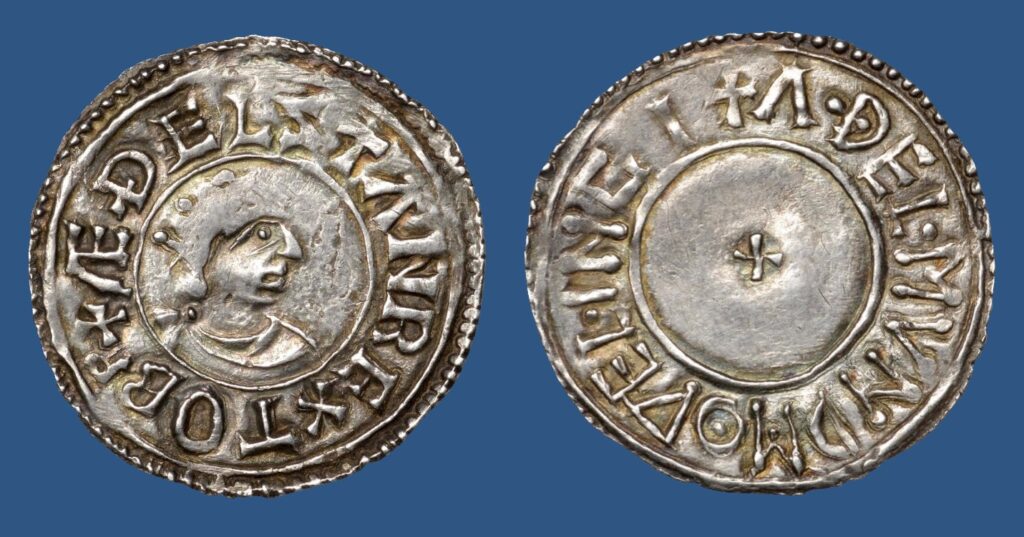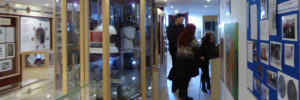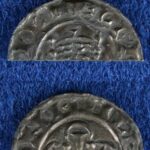We have in our collection examples of coins from many periods and the finds are still coming.
So when you are out and about keep an eye out as there may be another hoard just waiting to be discovered.
Roman
In 2007 an initial stash of 24 Roman coins were found in Milbourne, just outside of Malmesbury and a further 21 were discovered at the same site and are displayed in the museum. They are nummi and date from around 325AD. It has been suggested that they might have been the savings of a slave waiting for his release or possibly a child’s pocket money. They certainly were a poor person’s hoard as they were the equivalent of loose change.
Malmesbury Coin Hoard
The Malmesbury Coin Hoard was found by a metal detectorist in 2012 in a field in Milbourne, Malmesbury. This rare and fascinating find contains an amazing collection of 1266 Roman coins enclosed in the remains of its original pot. The coins are mainly from the early 4th century and reflect a highly dynamic period in Roman history when emperors were frequently changing.
The hoard is a gateway to an earlier time, inspiring everyone who sees it to imagine what life was like when Romans lived and farmed in the Malmesbury area.
With a generous grant from the Heritage Lottery Fund and grants from the Association of Independent Museums and the Malmesbury Area Board and donations, a team of volunteers were able to do the necessary recording and photographing of the coins to allow them to be professionally conserved.
This coin hoard is now on display in the museum and is shown in the links below. For more information see the Malmesbury Coin Hoard website.

Saxon & Norman Coins
In Anglo-Saxon and Norman times coins – silver pennies – were struck at many towns around England. In Wiltshire six towns had a mint; Malmesbury, Cricklade, Great Bedwyn, Marlborough, Salisbury and Wilton.
The coins are small, 12 to 13mm in diameter (a modern penny is 20mm), and made of silver. The correct weight of silver was placed on a die and then hit hard with a hammer bearing the die for the obverse side. This is why coins are said to be struck. The dies were issued centrally by the king. Usually one side bears an image of the king with an inscription giving his name and titles; the other bears a central cross, which differed slightly and round the perimeter the name of the moneyer where the coin was struck and the mint.
Coinage was used as a form of taxation. New coins were issued every few years. The old ones were no longer considered legal tender and so had to be handed in for less than their face value. In addition the mint had to pay a fee. The Domesday book records that Malmesbury paid 100 shillings a year for the right to have a mint. Malmesbury mint started c.985AD under Aethelred II and closed c.1095 in the reign of William II. Aethelred the Unready paid large amounts of Danegeld and so most of the Malmesbury coins have been found in Denmark. The output of the Malmesbury mint was low; initially it had two moneyers but in later years only one. This means Malmesbury silver pennies are scarce and hence expensive. With help Friends of Athelstan Museum have acquired five of these.
Athelstan Penny
Athelstan museum is delighted to have been able to purchase and display a rare silver penny of King Athelstan (or Æthelstan) 924-939.
This gives us a direct link to Athelstan, who has strong association with Malmesbury and after whom the museum is named.
After the entire country fell under Athelstan’s control he celebrated his position on charters and coins. Very few coins feature both Athelstan’s portrait and the extended title (Æthelstan rex to Brit, ‘King of All Britons’) as this coin does.

The expansion of West-Saxon control also increased the number of burghs striking money for the King. Athelstan’s attempts to organise his new network of mint-places involved the first widespread use of mint-signatures on England’s coinage. Hence we know that this coin was struck at the mint of Wallingford, Oxfordshire by the moneyer Æthelmund.
As of 2013, no other such penny of Wallingford was recorded in any public museum or institution.
The coin is graded as good very fine. There is some weakness on the crown – this is caused by a flaw in the die, and not from the coin being rubbed. The flan (the original blank disc from which a coin is struck) is full and round, with smooth surfaces and light toning. There are no cracks or significant areas of porosity. Within the corpus of Athelstan Portrait pennies, this is can be regarded as well above average in terms of preservation.
Text credit: Noonan’s Auction House
Aethelred II ‘Crux’ Penny
Struck at Malmesbury by the moneyer Ealdred. The inscription is EALDRED MO MALD. This translates as Ealdred moneyer at Malmesbury. Mald is an abbreviation for Mealdmesbyrig one of the saxon names for the town.
The letters C R V X (the cross) appear on the reverse. This coin is believed to have been struck between 991 and 997 and so is one of the earliest coins known to have been minted in Malmesbury.
It is thought this coin came from a Scandinavian find and was bought by the Museum in 1986.
Aethelred II ‘Long Cross’ Penny
Struck at Malmesbury by the moneyer Leofget. The inscription is: LEOFGET MO MALD (Leofget moneyer in Malmesbury).
This coin was struck between 997 and 1003 so followed our other Aethelred penny and is called long cross because the cross on the reverse extends to the edge of the coin.
This was purchased at the auction of the Doubleday collection and had previously been in the Richard Cyril Locket collection.
William I ‘Paxs’ Penny
Struck at Malmesbury by the moneyer Seword; the inscription reads SEPORD ON MMIILM (Seword at Malmesbury)
This coin is believed to have been struck at the end of the reign of William the Conqueror who died in 1087. However it has been suggested that the inscription Paxs on the reverse may relate to the coronation oath of William II (William Rufus) and so could be the first issued by that king.
This coin is believed to have come from the large hoard found in 1833 at Beaworth in Hampshire.
William II ‘Cross in Quatrefoil’ Penny
Struck at Malmesbury by the moneyer Seword. The inscription on this reads SEPORD ON MALM (Seword at Malmesbury)
Notice how the abbreviation for Malmesbury keeps changing. It is thought this coin was struck between 1089 and 1092. As the Malmesbury mint closed in 1095 this coin is among the last struck here.
William II ‘Cross in Quatrefoil’ Halfpenny
The same coin as the William II ‘Cross in Quatrefoil’ but converted into a halfpenny by literally cutting it in half with a pair of shears. To make a farthing, or fourthing, you repeated the process.
This coin was found in 1990 at the Vintry docks in London.
Other Coins and Tokens
In addition we have many coins including an ancient British base gold coin of the tribe of the Corieltauvi probably struck in late in the first century before Christ. It is based on the stater issued by Philip of Macedonia three centuries earlier. The original has a chariot on one side and on the other the head of Apollo, but because the design has been copied and recopied so many times the design on this coin is hardly recognisable.
Found at Easton Grey near the Fosse it could have been lost in Roman times even though the coin was struck nearly a hundred years earlier. It is the only coin of the Corieltauvi to have been found in Wiltshire.
The Corieltauvi (formerly thought to be called Coritani) were a tribe of East England based round Leicestershire and Lincolnshire.
Tokens
In common with many other towns Malmesbury traders issued tokens which could be redeemed against purchases. Whether these acted as a discount scheme or ‘Christmas Club’ is not known but it seems likely that both vendor and customer benefitted.
Tokens go back a long way; they were used in Roman times as a substitute coinage. In the second part of the seventeenth century they were tolerated by officialdom as an alternative coinage but by the nineteenth century much less tolerance was shown and because of this most tokens that were issued carry no defined value so that if proceeded against the issuer could claim they were just for advertising.
The museum has many examples from local shopkeepers.







